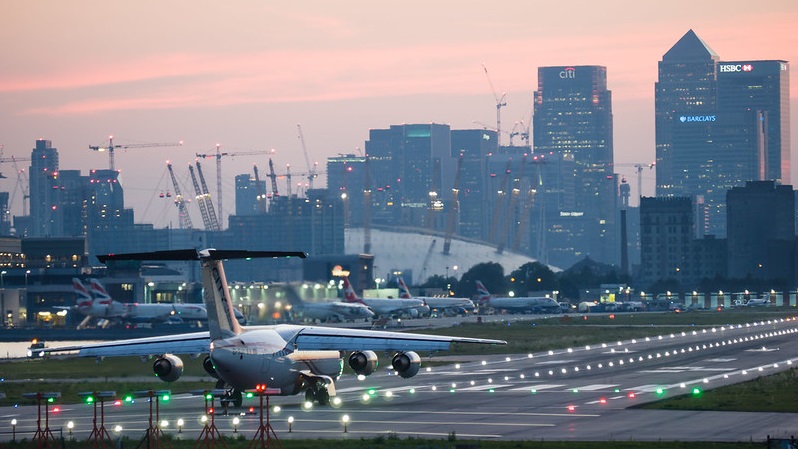The UK government decided expansion is compatible with its plan to cut aviation emissions, raising questions about its reliance on unproven techno-fixes over reducing flights
This week, the UK’s new centre-left government approved an expansion of London City Airport, which would allow the business travel hub to fly an extra 2.5 million passengers a year.
Monday’s approval follows similar green lights for airport expansion given by the previous centre-right government – and goes against the firm advice of the UK’s official climate change advisory body, as well as opposition from climate campaigners and East Londoners concerned about noise and carbon pollution.
The Climate Change Committee said last June that “there should be no net airport expansion across the UK” and “no airport expansions should proceed until a UK-wide capacity management framework is in place”. A spokesperson told Climate Home this remains the committee’s position.
But, approving the London City expansion, Labour ministers Angela Rayner and Louise Haigh said in a statement that the lifting of the cap from 6.5 million to 9 million passengers a year would bring more jobs and tourists to London and boost business productivity. They added that the expansion would not conflict with the government’s “Jet Zero Strategy” – to clean up aviation – nor prevent the UK from meeting its 2050 net zero target because the additional emissions would not be significant.
Sign up to get our weekly newsletter straight to your inbox, plus breaking news, investigations and extra bulletins from key events
Climate campaigners said the move highlights the flaws of the UK’s airport planning policy and its Jet Zero Strategy, which aims to cut emissions from aviation with cleaner fuels, carbon offsets and carbon dioxide (CO2) removal machines while passenger numbers increase by about half between 2018 and 2050.
Other bigger London airports – including Heathrow, Gatwick, Luton and Stansted – are also considering expansion or seeking permission to expand.
For the London City decision, ministers relied heavily on advice from two planning inspectors – Claire Searson and Johanna Ayres. The inspectors concluded that, according to the Jet Zero Strategy, the emissions from airport expansions can be “accommodated within the planned trajectory for achieving net zero emissions by 2050” and therefore “our planning policy frameworks remain compatible with the UK’s climate change obligations”.
The Jet Zero Strategy was published by the last Conservative government in July 2022. It aims to reach net zero in the aviation sector by 2050 – a goal it says is “hugely challenging”.
In a world first, Grenada activates debt pause after Hurricane Beryl destruction
Alethia Warrington, a climate campaigner at an NGO called Possible, told Climate Home the UK was “ahead of the curve” compared to other countries in setting this target but that its projections for passenger growth were “incredibly dangerous”. Possible is challenging the strategy in court. Greenpeace campaigner Paul Morozzo said the strategy was built on “false hope”.
The plan does not include any measures to limit the number of flights or the capacity of airports, allowing planning inspectors and ministers to conclude that airport expansions are not counter to the strategy.
Instead, it plans to achieve just under half of the sector’s emissions reductions by buying carbon offsets. But many carbon offsets – where the buyer pays someone else to reduce emissions on their behalf – have been found not to deliver the emissions savings they claim.
The Jet Zero Strategy plans to get about a quarter of the emissions cuts needed from fuel efficiency improvements, another quarter from “sustainable aviation fuels” (SAFs) and a small amount from zero-emission aircraft.
Many airlines are buying more fuel-efficient aircraft, shaving a chunk off their planet-heating pollution. But the viability and sustainability of SAFs has been challenged by campaigners, regulators and even airline executives.
Currently, the only non-fossil fuel commercially available for planes is made from biomass, turning crops like corn, soy and oil palm, or used cooking oil, into jet fuel.
But there is nowhere near enough of this being produced to meet demand. Ryanair CEO Michael O’Leary said in December “there isn’t enough cooking oil in the world to power more than one day’s aviation”. As a result, SAF is currently more than four times as expensive as regular oil-based jet fuel.
Biofuels also often compete with food crops, worsening hunger and encouraging deforestation. The UK’s advertising regulator recently ruled that
Read More

